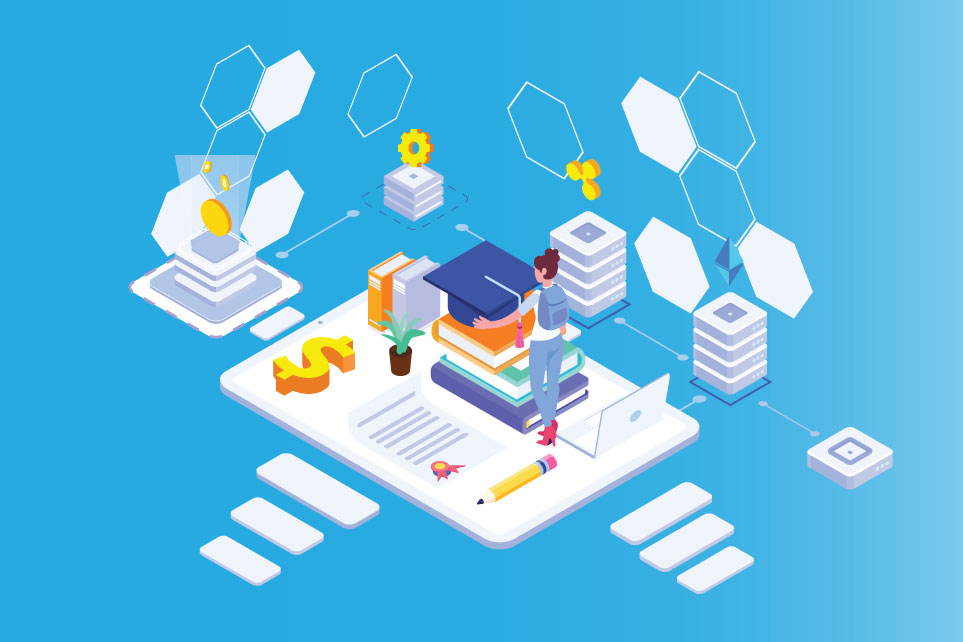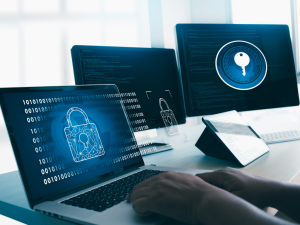Blockchain in Education: Tamper-Proof Transcripts & Diplomas
Colleges are beginning to use blockchain technology to make student transcripts and diplomas completely tamper-proof. Instead of relying on printed certificates or traditional databases that can be forged or misplaced, blockchain creates a secure, digital record of every achievement.
Each credential whether it’s a course completion, transcript, or full degree is stored on a decentralized, encrypted ledger that can’t be altered without the network detecting it. This makes academic records more trustworthy, instantly verifiable, and accessible from anywhere.
Employers or universities can confirm a student’s qualifications in seconds, without waiting for administrative approval. More importantly, students gain full ownership of their records, deciding who can view them and when.
For education systems that have long struggled with slow verification and document fraud, blockchain offers a new standard of transparency and security. It’s not about replacing universities, but about strengthening the way their achievements are recorded and trusted.
So, what exactly makes blockchain so reliable and why are colleges investing in it now?
Understanding Blockchain: What It Really Means for Students
Before diving into how colleges are using it, it helps to understand what blockchain actually is and why it’s suddenly showing up in education.
At its core, blockchain is a digital record book that’s shared across many computers instead of being stored in one single place. Every time new information is added, say, your latest grade, a completed course, or a diploma it’s stored as a “block.” Each block is connected to the one before it, forming a continuous “chain.” Once a block is added, it’s nearly impossible to change or delete it without everyone in the network noticing.
This simple design makes blockchain incredibly secure and transparent. There’s no single person or office controlling the data, which means no one can secretly alter or forge it. The system runs on cryptography complex digital codes that lock each record making it trustworthy by design.
In education, that means your achievements don’t sit inside a college database or depend on paper certificates. Instead, they live on a decentralized, tamper-proof network that verifies their authenticity automatically. Even years after graduation, your credentials remain intact and accessible.
Think about how that changes things:
- If you apply to a university abroad, they can verify your previous degree instantly.
- If you send your resume to an employer, they can check your qualifications without contacting your college.
- If you transfer schools, your credits move with you with no endless paperwork.
For students, this creates a future where records are secure, portable, and truly yours. You won’t have to depend on institutions to prove your academic history, you’ll hold it yourself.
That’s why blockchain is such a big deal in higher education. It’s not about turning classrooms into tech labs; it’s about giving students more power over their achievements and making education systems more efficient and transparent.
Now that we understand how it works, let’s look at how colleges are actually using it in real life from digital diplomas to instant transcript verification.
How Colleges Are Using Blockchain
Across universities, something interesting is happening behind the scenes. Instead of printing degrees on paper and filing transcripts in office cabinets, colleges are starting to issue them on blockchain networks, a digital system that keeps every record secure, verifiable, and permanent.
When a student graduates, their diploma is created as a digital credential. It’s not a PDF or scan but a unique entry stored on the blockchain, protected by encryption. This entry includes a special code, a hash that serves like a fingerprint. If anyone tries to change even a single letter or grade, the hash no longer matches, making tampering instantly visible.
That single detail changes everything. Employers no longer have to call the college or wait weeks for a transcript. With blockchain credentials, verification takes seconds. A hiring manager can click a link, check the authenticity, and move forward confidently.
For colleges, it removes a mountain of paperwork and verification requests. For students, it ensures their achievements can never be lost, faked, or altered.
At the Massachusetts Institute of Technology (MIT), graduates now receive their diplomas directly on their phones. Through the university’s “Blockcerts” project, each student owns a verifiable digital degree that can be shared anywhere from job applications to postgraduate admissions. The University of Nicosia in Cyprus uses a similar system, offering blockchain-backed degrees for both local and international students.
But it’s not just about diplomas. Blockchain is also being used to manage entire academic histories. Every completed course, credit, or certification can be recorded in a shared ledger, protected from manipulation or deletion. Because the system is decentralized meaning no single institution controls it the records remain safe even if a university’s database crashes or a server is compromised.
This decentralization also makes it easier for universities to collaborate. Imagine a student transferring from one college to another instead of chasing forms and approvals, both institutions can access and verify the student’s records from the blockchain. It’s transparent, instant, and error-free.
Beyond traditional degrees, blockchain is being tested for short courses, online certifications, and skill badges too. As education becomes more flexible, students often build their qualifications piece by piece through workshops, MOOCs, or internships. Blockchain allows all these experiences to be recorded together, forming a single, lifelong learning profile that can grow over time.
Slowly but steadily, academic records are shifting from physical documents and fragile databases to living digital identities that students can carry with them anywhere. Every credential tells part of their story, one that can’t be erased, rewritten, or questioned.
Why Blockchain Is a Game-Changer for Students
For most students, a degree is more than a piece of paper; it’s proof of years of effort, learning, and persistence. Yet the way those achievements are recorded hasn’t changed much in decades. Blockchain brings a quiet but powerful shift by turning academic records into something living, portable, and built on trust.
The first big difference is authenticity. Fake degrees and forged certificates have been a serious problem for universities and employers worldwide. Blockchain ends that debate once and for all. Every legitimate record is digitally signed and time-stamped, making forgery nearly impossible. When a credential sits on the blockchain, its originality is never in question. It’s a permanent, verifiable truth.
Then comes accessibility. Students no longer need to wait for paperwork or approvals to prove what they’ve earned. Whether you’re applying for a master’s degree abroad or your first job after graduation, your verified record can be shared instantly. It travels with you not as a fragile document, but as a secure digital identity that’s available whenever and wherever you need it.
This also opens the door to greater mobility. Education is no longer confined to one institution or country. Students move between colleges, take online courses, and stack credentials from multiple programs. Blockchain keeps all of it in one place. Each achievement from a semester project to a full degree adds another verified block to your academic chain. It’s like building a single, connected story of your learning journey.
Another major shift is ownership. For decades, universities controlled how student data was stored and shared. You could request your transcript, but you didn’t truly “own” it. Blockchain flips that dynamic completely. The data sits in your digital wallet, and you decide who gets to see it. You can share it with an employer for verification, send it to a university for credit transfer, or keep it private until needed. Your academic history becomes something you manage, not something you request.
Employers, too, benefit from this transparency. Instead of relying on emailed PDFs or reference letters, they can check credentials instantly. This builds trust on both sides. Graduates get recognition without delays, and companies make faster, more confident hiring decisions.
Beyond degrees and jobs, blockchain has a subtler effect: it encourages lifelong learning. As online courses and micro-credentials become common, students can keep adding to their blockchain record throughout life. You might earn a cybersecurity badge at 18, complete a teaching degree at 22, and later pursue design certification all verified and visible in one digital space. Education becomes fluid, continuous, and personal.
For many students, this also means fairer opportunities. Blockchain reduces barriers that once favoured those with connections or access to well-funded institutions. When your achievements are verified on an open, global platform, talent speaks louder than geography or paperwork.
In short, blockchain changes how education feels. It removes friction, builds credibility, and gives students confidence that their work and effort are permanently secure. It’s not a flashy innovation but a quiet one, the kind that strengthens the foundation of how learning is recorded, recognised, and rewarded.
And that foundation is what every future student will build upon.
The Technology Behind It?
Behind all the talk of transparency and security lies a simple idea: every record on the blockchain is connected to another, forming a chain of trust.
When a university issues a digital diploma or transcript, it becomes a block of data. This block is locked with a cryptographic code, or hash, which acts like a digital seal. That seal ensures no one can open or alter the information without leaving a trace. Once the block is sealed, it’s linked to the previous one, creating a permanent chain of records.
If someone were to try and change a record, say, to fake a grade or alter a name the chain would immediately break. Every other computer connected to the network would see the mismatch and reject it. This makes tampering practically impossible.
What’s even more interesting is how verification works. Employers or universities don’t need direct access to a college’s database anymore. With the public key attached to your credential, they can instantly confirm whether it’s genuine. The data itself stays private, but its authenticity is visible to anyone who checks.
Think of it as a system that combines security with openness. The details of your academic record are encrypted and protected, yet the proof of their truth is public. No passwords, no back-and-forth emails just trust built into the technology itself.
This system runs across many computers, not one central server. That’s what makes it decentralized. Even if one part of the network goes down, the rest keeps running. No single institution owns or controls it, so the data remains safe, distributed, and permanent.
In the context of education, this technology quietly eliminates one of the biggest sources of uncertainty: the question of whether an academic record can truly be trusted. On blockchain, the answer is always yes, because the proof is built into every block.
The Future of Student Records
The shift to blockchain isn’t just a short-term upgrade for record keeping; it’s laying the foundation for how education will function in the years ahead. When every certificate, credit, and diploma can be securely stored and verified online, the entire system of academic record management starts to evolve.
The most immediate change will be the end of credential fraud. With every qualification verified and time-stamped on the blockchain, fake degrees lose their value completely. Each record carries a traceable history of who issued it, when, and for whom information that can’t be faked or erased. This restores trust between students, universities, and employers, creating a fairer academic environment for everyone.
Another major change lies in how easily students can move between institutions. Credit transfers, which often take weeks of verification, could become instant. If both universities use blockchain, the new institution can instantly verify completed courses and grades without endless documentation or manual checks. It removes barriers that once made higher education rigid and slow to adapt.
This flexibility also supports global mobility. A student from India applying to a university in Canada could share blockchain-verified transcripts within seconds. No courier delays, no attestation processes, no risk of lost paperwork. Education becomes borderless, powered by technology that works the same everywhere.
For universities, blockchain opens a new layer of insight and innovation. The secure, digitized data collected across programs can help institutions understand which courses perform best, how graduates fare in the job market, and where improvements are needed. Because the records are verified and tamper-proof, the analysis becomes more accurate, guiding smarter decisions.
Perhaps the most exciting outcome is the rise of lifelong digital learning portfolios. Education doesn’t stop after graduation anymore. With blockchain, every certification, online course, and skill badge can live together in one secure digital profile. Students can build a record that evolves with their careers a single, trusted source that reflects both formal education and personal growth.
Step by step, student records are moving from dusty files and scattered PDFs to something far more powerful: a transparent, portable, and student-owned system that reflects a lifetime of learning. It’s a transformation that feels inevitable, not futuristic.
Challenges and Considerations
Like any new technology, blockchain in education comes with its own hurdles. The idea sounds simple: store and verify credentials securely but turning that into everyday practice across thousands of institutions takes time, money, and coordination.
The first challenge is cost and technical readiness. Setting up a blockchain-based credential system requires infrastructure, expertise, and staff training. Large universities with tech departments can manage it, but smaller colleges may find it harder to adopt without external support or partnerships. Over time, as open-source tools and government-backed systems become available, this gap is expected to narrow.
Then there’s data privacy. While blockchain records are encrypted, schools still need to decide what kind of information should actually go on the blockchain. Most prefer storing only the credential’s verification code (its “hash”) rather than full transcripts, keeping personal data protected. Balancing transparency with privacy will remain a key discussion as the technology scales.
Regulation is another factor. Education systems operate differently across countries, and there’s no universal standard yet for blockchain-based credentials. For global recognition to work, governments, accreditation boards, and universities must agree on shared protocols. Progress is being made, but it will take cooperation at every level.
Finally, there’s the question of adoption speed. Universities are traditionally slow to change, and many are still testing blockchain through pilot programs. Convincing faculty and administrators to replace long-standing processes will take patience and evidence that the system truly works better.
Despite these challenges, momentum is building. The benefits of authenticity, ownership, and efficiency are too valuable to ignore. What’s happening now feels similar to the early days of online learning platforms: uncertain at first, but destined to become the norm.
Each new project brings the education system a little closer to a transparent, global network of verified academic records, one that works for both institutions and students.
What Does It Mean for Students Right Now?
For students currently in college or just about to start, blockchain might sound like a distant concept something only tech experts talk about. But it’s already reshaping how academic records work, even if you don’t notice it yet.
When you graduate in a few years, there’s a good chance your diploma won’t arrive in an envelope. It’ll show up as a secure digital credential you can store on your phone or laptop. You’ll be able to share it with an employer or another university instantly, and they’ll verify it within seconds, no waiting for official stamps, no chasing emails from the registrar’s office.
If you take a few online courses, join a certification program, or study abroad, all those achievements can live together in one verified digital record. It becomes your personal learning portfolio, something that grows with you as you pick up new skills and qualifications.
This shift also means fewer barriers for students from different backgrounds. Those who can’t afford to courier documents, deal with verification delays, or navigate complex bureaucracy will finally have an easier, faster system that treats every credential equally. Blockchain doesn’t just protect data; it helps level the playing field.
For universities, it’s a new way to stay connected with alumni. Once your records are on blockchain, they remain verifiable forever. Even ten years down the line, you can access your diploma instantly, share it for further studies, or prove your qualifications for a new role abroad.
All of this points to one simple truth: blockchain is quietly putting students in charge of their own academic identity. It’s giving you control, freedom, and proof that your hard work truly belongs to you not to an institution or a piece of paper.
The change is already underway. And for the next generation of learners, it won’t just be about earning a degree it’ll be about owning it.
Conclusion
Blockchain is doing something simple yet powerful, it’s making education more trustworthy. By turning degrees, transcripts, and certificates into secure digital records, it removes the need for endless verification, prevents forgery, and gives students full control over their achievements.
For universities, it means faster processes and global credibility. For employers, it means hiring decisions based on verified truth. But for students, it represents something far more personal: the freedom to own and protect the story of their education.
As colleges continue to test and refine blockchain systems, the paper degree hanging on the wall may slowly give way to a digital one stored securely in your virtual wallet. The value of education won’t change but the way it’s recorded and shared certainly will.
It’s a quiet revolution, happening one credential at a time. The real question is: when this becomes the new normal, will future graduates ever need to ask, “Can you verify my degree?” again?
FAQs: Blockchain in Education
1. How is blockchain used in education?
Blockchain is used to issue, store, and verify academic credentials such as degrees, transcripts, and certificates. Instead of relying on paper documents, universities record each credential as a secure, digital entry on a blockchain network that can be verified anytime, anywhere.
2. What makes blockchain secure and tamper-proof?
Every credential stored on the blockchain has a unique digital signature called a hash. If anyone tries to alter a record, even slightly, the hash changes immediately — alerting the network and rejecting the change. This makes tampering virtually impossible.
3. Can others see my personal information?
No. The blockchain only displays proof that your credential is genuine, not your private details. You control who can access your information and can share verification links selectively with employers or universities.
4. Will all colleges switch to blockchain-based credentials?
Many leading institutions have already started. Universities like MIT and the University of Nicosia are early adopters, while others are testing pilot programs. Over the next few years, blockchain credentials are expected to become increasingly common.
5. How does blockchain help students studying or working abroad?
It makes verification instant and borderless. Universities and employers in any country can confirm your credentials without paperwork or delays, simplifying applications and global career opportunities.






